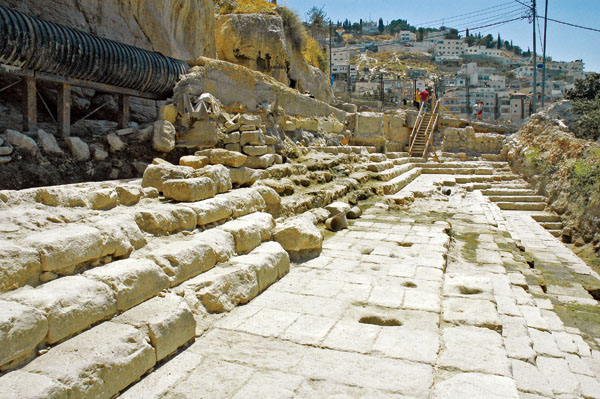“He spit on the ground, made some mud with the saliva, and put it on the man’s eyes. “Go,” He told him, “wash in the Pool of Siloam” (this word means “Sent”). So the man went and washed, and came home seeing.” (John 9:6 NIV)
Healing might get messy before we are made whole.
This blind man was minding his own business, making his way through life when Jesus saw him, sought him out and threw things into a tailspin. His miracle involved only two sentences, but the preface and the prologue required an entire chapter.
Jesus came up to the blind man, spat on the ground to make a mud compote and applied it to unseeing eyes with unusual instructions. “Go wash in the Pool of Siloam.” Little did this blind man know he had just been commissioned for a missions trip. He was sent by the Messiah across town and his very life was to become the message.

Archaeological discovery places the Pool of Siloam south of the Temple in the Kidron Valley. This connects well with biblical text about Hezekiah’s tunnel and accompanying pools that sustained the City of David during the Assyrian siege. The interesting thing about the Pool of Siloam, though, is that it was subject to run-off. It’s location at the bottom of the valley made it prone to collecting silt and mud. So this would mean Jesus put mud on a blind man’s eyes and sent him away to bathe in a muddy tub. Ironically, this is how the man regained his sight; the power of God is blatant, even to an unbeliever.
I wonder, who walked with the blind man? How did he successful make his descent from the Temple to the Pool? What was he thinking as he stumbled blindly down narrow, rocky streets with a mud-caked face and a flicker of hope in his soul?
I’m learning, like the blind man, that healing sometimes makes life messier before we find ourselves made whole. Often, there is a process involved, a process that doesn’t make sense in the natural. We note also, that even when the blind man could finally see, his restoration wasn’t yet complete.
See, Jesus had shown Himself as Creator and Re-Creator. Only God makes something from mud. This, of course, caused a big problem with the Pharisees. They interviewed the no-longer blind man relentlessly, even subpoenaed his parents into their litigation. The Pharisees turned the man’s two sentence healing into a three-ring circus that culminated in their expulsion of him from the Temple. Where would he worship? How would he make his thank offerings? I wonder if the man had begun to wish Jesus never had laid eyes on him in the first place?
Yet, when the Savior saw and heard all this, He sought out the seeing man and called him to Himself. Jesus revealed His identity and the man saw Him as Savior. He professed his belief and began to worship. This was the moment he was fully healed.
Sometimes the path to total healing is messy and prolonged. Onlookers will not understand. There will be people along our way that will question and even persecute. Our desire for complete restoration will likely upset the neatly stacked apple cart of our lives. But it’s worth it. The total healing we are after is worth whatever upset or mess might be involved along the way. Like the man with eyes open, we just keep looking for Jesus in our story. We profess Who we know Him to be and we worship Him until our healing is complete.
“Then the man said, “Lord, I believe.” and he worshiped Him.” (John 9:38 NIV)
Lord, we weren’t looking for a complete healing. Like the man in the text, we were just trying to survive. But You came into our lives and recognized the depth of our need. You touched us, made things messy and set us on a path to wholeness. Though this process pushes us out of our routines and comfort zones, we’ve found You as Savior and could never go back to life as it was before this encounter. Thank You for loving us enough to get involved, to open our eyes and walk us toward total restoration. We see You as Lord and respond in worship. You are worthy, Creator/Re-Creator. Amen.